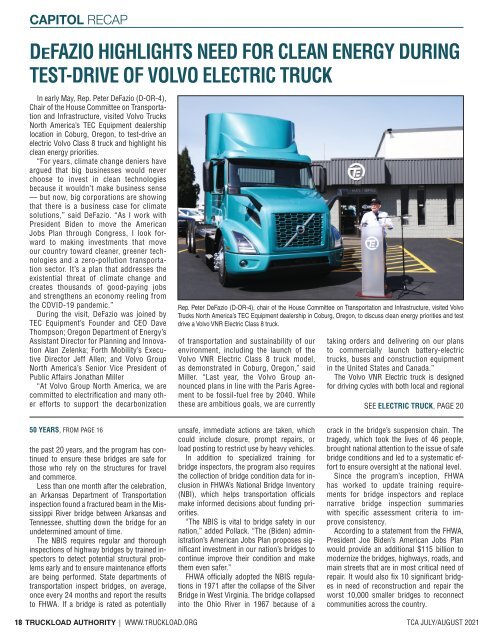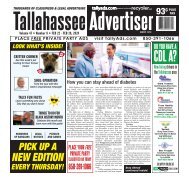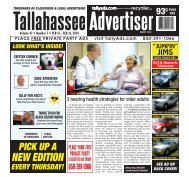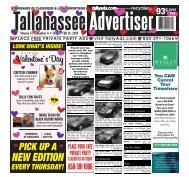TLA49_AllPages
You also want an ePaper? Increase the reach of your titles
YUMPU automatically turns print PDFs into web optimized ePapers that Google loves.
DEFAZIO HIGHLIGHTS NEED FOR CLEAN ENERGY DURING<br />
TEST-DRIVE OF VOLVO ELECTRIC TRUCK<br />
In early May, Rep. Peter DeFazio (D-OR-4),<br />
Chair of the House Committee on Transportation<br />
and Infrastructure, visited Volvo Trucks<br />
North America’s TEC Equipment dealership<br />
location in Coburg, Oregon, to test-drive an<br />
electric Volvo Class 8 truck and highlight his<br />
clean energy priorities.<br />
“For years, climate change deniers have<br />
argued that big businesses would never<br />
choose to invest in clean technologies<br />
because it wouldn’t make business sense<br />
— but now, big corporations are showing<br />
that there is a business case for climate<br />
solutions,” said DeFazio. “As I work with<br />
President Biden to move the American<br />
Jobs Plan through Congress, I look forward<br />
to making investments that move<br />
our country toward cleaner, greener technologies<br />
and a zero-pollution transportation<br />
sector. It’s a plan that addresses the<br />
existential threat of climate change and<br />
creates thousands of good-paying jobs<br />
and strengthens an economy reeling from<br />
the COVID-19 pandemic.”<br />
During the visit, DeFazio was joined by<br />
TEC Equipment’s Founder and CEO Dave<br />
Thompson; Oregon Department of Energy’s<br />
Assistant Director for Planning and Innovation<br />
Alan Zelenka; Forth Mobility’s Executive<br />
Director Jeff Allen; and Volvo Group<br />
North America’s Senior Vice President of<br />
Public Affairs Jonathan Miller<br />
“At Volvo Group North America, we are<br />
committed to electrification and many other<br />
efforts to support the decarbonization<br />
Rep. Peter DeFazio (D-OR-4), chair of the House Committee on Transportation and Infrastructure, visited Volvo<br />
Trucks North America’s TEC Equipment dealership in Coburg, Oregon, to discuss clean energy priorities and test<br />
drive a Volvo VNR Electric Class 8 truck.<br />
of transportation and sustainability of our<br />
environment, including the launch of the<br />
Volvo VNR Electric Class 8 truck model,<br />
as demonstrated in Coburg, Oregon,” said<br />
Miller. “Last year, the Volvo Group announced<br />
plans in line with the Paris Agreement<br />
to be fossil-fuel free by 2040. While<br />
these are ambitious goals, we are currently<br />
taking orders and delivering on our plans<br />
to commercially launch battery-electric<br />
trucks, buses and construction equipment<br />
in the United States and Canada.”<br />
The Volvo VNR Electric truck is designed<br />
for driving cycles with both local and regional<br />
SEE ELECTRIC TRUCK, PAGE 20<br />
50 YEARS, FROM PAGE 16<br />
the past 20 years, and the program has continued<br />
to ensure these bridges are safe for<br />
those who rely on the structures for travel<br />
and commerce.<br />
Less than one month after the celebration,<br />
an Arkansas Department of Transportation<br />
inspection found a fractured beam in the Mississippi<br />
River bridge between Arkansas and<br />
Tennessee, shutting down the bridge for an<br />
undetermined amount of time.<br />
The NBIS requires regular and thorough<br />
inspections of highway bridges by trained inspectors<br />
to detect potential structural problems<br />
early and to ensure maintenance efforts<br />
are being performed. State departments of<br />
transportation inspect bridges, on average,<br />
once every 24 months and report the results<br />
to FHWA. If a bridge is rated as potentially<br />
unsafe, immediate actions are taken, which<br />
could include closure, prompt repairs, or<br />
load posting to restrict use by heavy vehicles.<br />
In addition to specialized training for<br />
bridge inspectors, the program also requires<br />
the collection of bridge condition data for inclusion<br />
in FHWA’s National Bridge Inventory<br />
(NBI), which helps transportation officials<br />
make informed decisions about funding priorities.<br />
“The NBIS is vital to bridge safety in our<br />
nation,” added Pollack. “The (Biden) administration’s<br />
American Jobs Plan proposes significant<br />
investment in our nation’s bridges to<br />
continue improve their condition and make<br />
them even safer.”<br />
FHWA officially adopted the NBIS regulations<br />
in 1971 after the collapse of the Silver<br />
Bridge in West Virginia. The bridge collapsed<br />
into the Ohio River in 1967 because of a<br />
crack in the bridge’s suspension chain. The<br />
tragedy, which took the lives of 46 people,<br />
brought national attention to the issue of safe<br />
bridge conditions and led to a systematic effort<br />
to ensure oversight at the national level.<br />
Since the program’s inception, FHWA<br />
has worked to update training requirements<br />
for bridge inspectors and replace<br />
narrative bridge inspection summaries<br />
with specific assessment criteria to improve<br />
consistency.<br />
According to a statement from the FHWA,<br />
President Joe Biden’s American Jobs Plan<br />
would provide an additional $115 billion to<br />
modernize the bridges, highways, roads, and<br />
main streets that are in most critical need of<br />
repair. It would also fix 10 significant bridges<br />
in need of reconstruction and repair the<br />
worst 10,000 smaller bridges to reconnect<br />
communities across the country.<br />
18 TRUCKLOAD AUTHORITY | WWW.TRUCKLOAD.ORG TCA JULY/AUGUST 2021

















